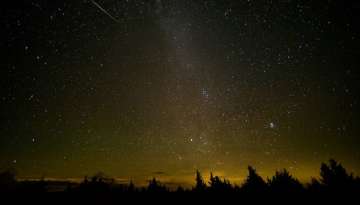The world is set to witness the Perseid meteor shower today and tomorrow (August 11 and 12). According to NASA, Comet NEOWISE is making its way out of the solar system. Perseid meteors, caused by debris left behind by the Comet Swift-Tuttle, had begun streaking across the skies in late July and will peak in the pre-dawn hours of August 12, the American space agency has said.
The Perseid meteor shower is often considered to be one of the best meteor showers of the year due to its high rates and pleasant late-summer temperatures. This year’s shower, however, has the unfortunate circumstance of the Moon phase—last quarter—impeding the view of the shower peak, reducing the visible meteors from over 60 per hour down to 15-20 per hour.
The Perseids, however, are rich in bright meteors and fireballs, so it will still be worth going out in the early morning to catch some of nature’s fireworks.
Why are they called Perseids?
All meteors associated with one particular shower have similar orbits, and they all appear to come from the same place in the sky, called the radiant. Meteor showers take their name from the location of the radiant. The Perseid radiant is in the constellation Perseus. Similarly, the Geminid meteor shower, observed each December, is named for a radiant in the constellation Gemini.
When to watch Perseid meteor shower
According to NASA, skygazers across the world should stay up late on the night of August 11 or should wake up early on August 12 to watch Perseid meteor shower. The Perseids are best seen between about 2 am and dawn. The Moon rises at around midnight, so its brightness will affect the peak viewing window. However, even though the Moon’s phase and presence will keep the frequency of visible meteors lower, there is still nearly one meteor every two minutes during the peak.
If those hours seem daunting, skygazers can also go out after dark, around 9 pm and see a few Perseids. However, it should be noted that the morning hours would still come up with more stars.
Perseid meteor shower LIVE streaming
A live broadcast of the meteor shower from a camera at NASA’s Marshall Space Flight Center in Huntsville, Alabama, will be available on the NASA Meteor Watch Facebook starting around 8 pm CDT on August 11 and continuing until sunrise on August 12. Meteor videos recorded by the NASA All Sky Fireball Network are also available each morning; to identify Perseids in these videos, look for events labeled “PER.”
Will Perseid meteor shower be visible in India?
The Perseid meteor shower will peak on Tuesday (August 11) but will be visible throughout Wednesday and Thursday (August 11-12).
In India, the celestial event will be visible on two days - Tuesday and Wednesday. The visibility of meteors will be high in the night from 2 am to pre-dawn hours.
How to watch Perseids?
If it’s not cloudy, pick an observing spot away from bright lights, lay on your back, and look up! You don’t need any special equipment to view the Perseids – just your eyes. (Note that telescopes or binoculars are not recommended because of their small fields of view.) Meteors can generally be seen all over the sky so don’t worry about looking in any particular direction.
While observing this month, not all of the meteors you’ll see belong to the Perseid meteor shower. Some are sporadic background meteors. And some are from other weaker showers also active right now, including the Alpha Capricornids, the Southern Delta Aquariids, and the Kappa Cygnids. How can you tell if you’ve seen a Perseid? If you see a meteor try to trace it backward. If you end up in the constellation Perseus, there’s a good chance you’ve seen a Perseid. If finding constellations isn’t your forte, then note that Perseids are some of the fastest meteors you’ll see!
Pro tip: Remember to let your eyes become adjusted to the dark (it takes about 30 minutes) – you’ll see more meteors that way. Try to stay off of your phone too, as looking at devices with bright screens will negatively affect your night vision and hence reduce the number of meteors you see.
